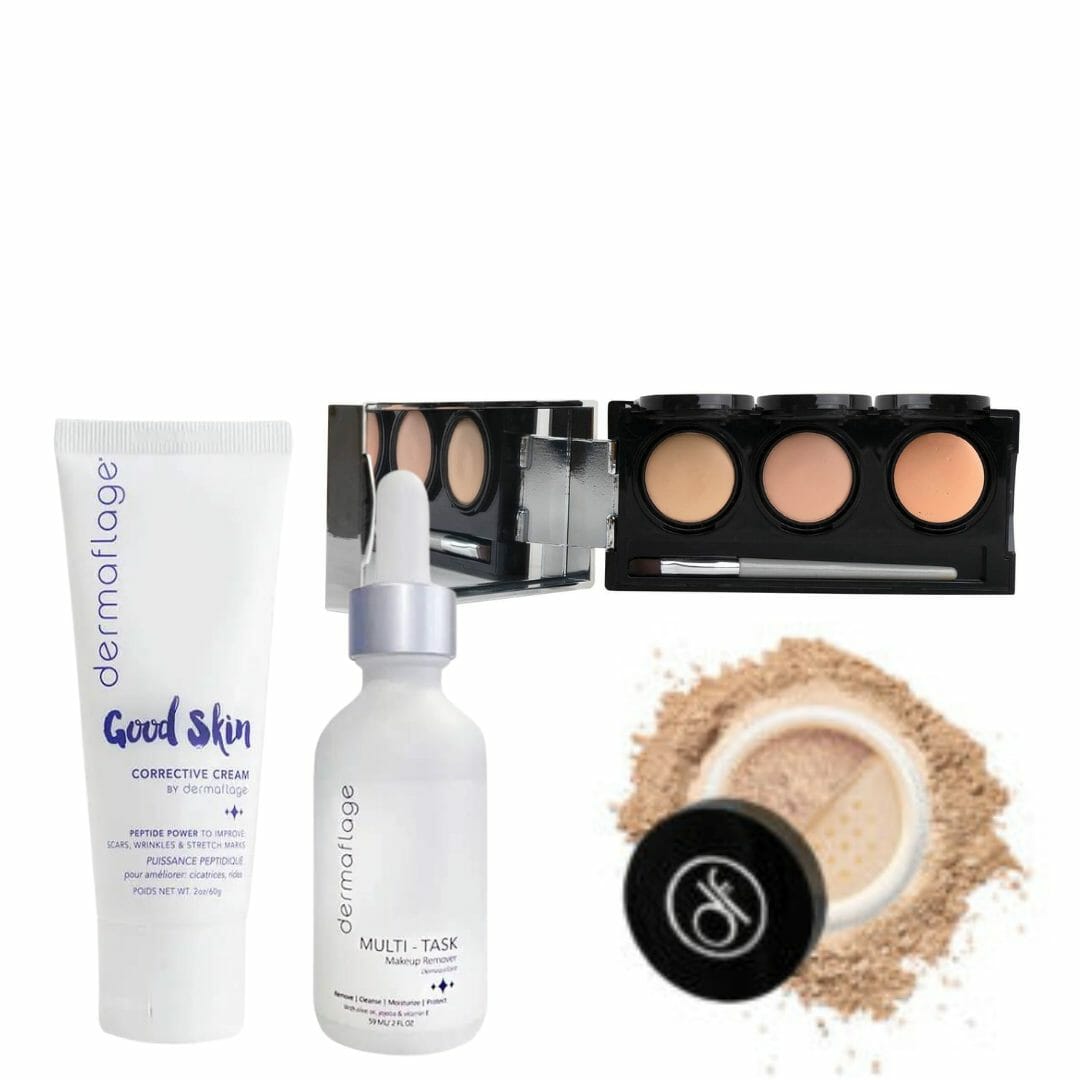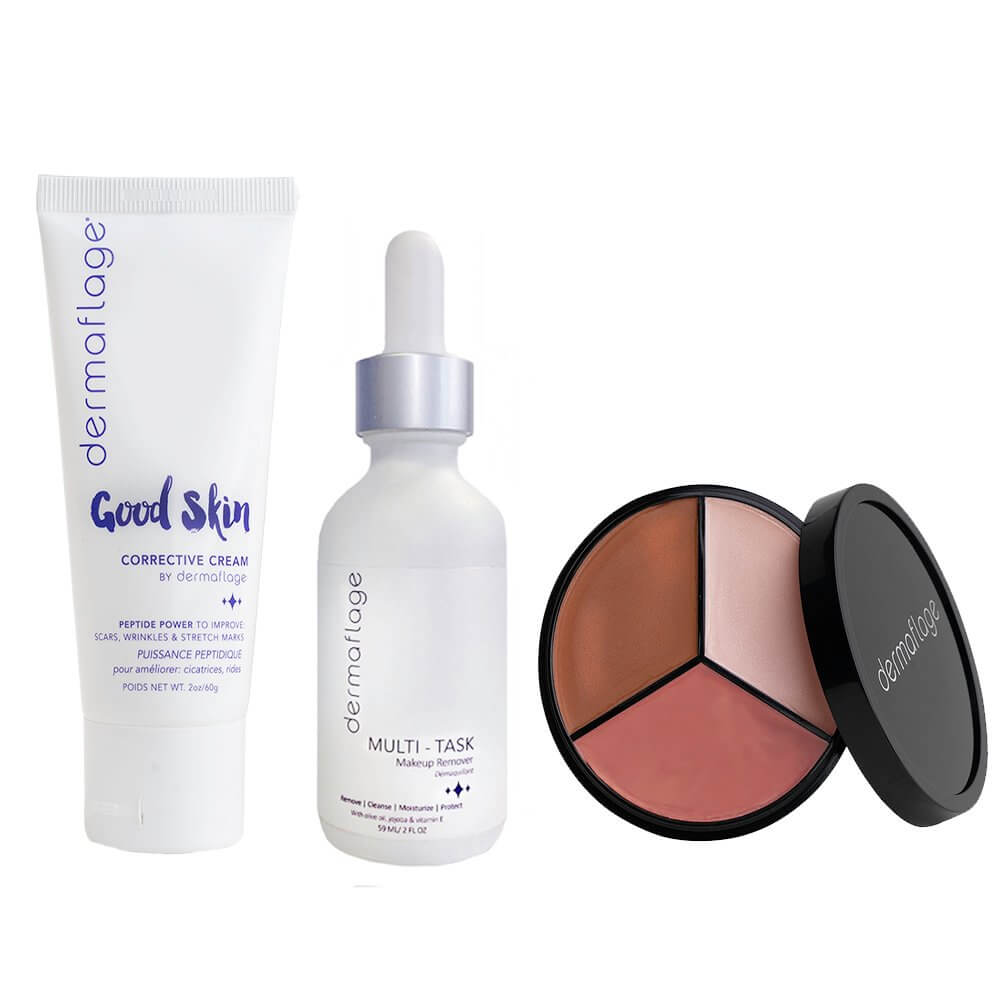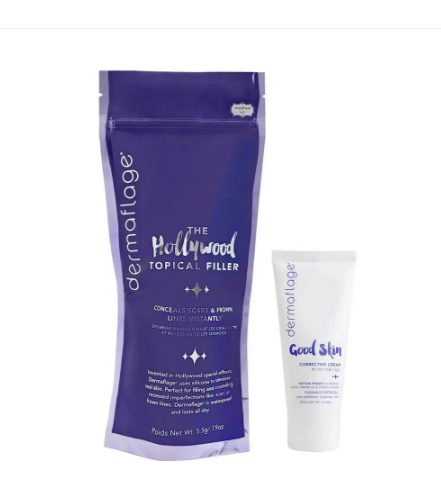

Melasma is a relatively common skin condition that results in dark spots and patches on the face. It can be mistaken for other types of skin conditions, so board-certified dermatologists are careful to provide an accurate diagnosis and tailored treatment plans. They are also careful with their advice on how to cure melasma from the inside.
Although melasma isn’t contagious, many women still get self-conscious about the appearance of unnatural spots and patches on their face. This is one of the reasons Dermaflage developed its Behind the Scenes Concealer — a super-pigmented concealer that is specially formulated to hide the toughest skin discolouration on the face and body. It’s a waterproof formulation that provides full coverage. It can cover acne, age spots, dark circles, hyperpigmentation, melasma, scars, bruises, and other imperfections.
Our beauty and skincare experts don’t stop there, though. We share everything relevant to your skin concerns so you can feel confident inside out. Keep reading below about melasma causes and the best treatment for melasma on face.

What are the 3 Different Types of Melasma?
Melasma is a common skin condition that is characterised by light brown, dark brown, and blue-grey areas on the skin. They might take the form of flat patches or freckles across the face, especially on the cheekbones, upper lip, and forehead; the arms, neck, and back are frequently affected, too.
Melasma dark patches on face and forearms change over time — they get worse in the summer and usually improve during the winter. This is because the symptoms of melasma are often triggered by exposure to sunlight.
Another name for melasma, “pregnancy mask,” refers to the fact that it affects 15% to 50% of pregnant women. In total, around 1.5% to 33% of the population experience melasma, particularly during women’s reproductive years, or between 20 to 40 years of age.
It’s also worth noting that fairer-skinned people have a lower risk of melasma, compared to those who tan easily or those with darker brown skin.
Melasma is classified into three categories based on the depth of hyperpigmentation or darker spots on the skin: Epidermal, dermal, and mixed melasma. A Wood’s lamp that generates black light is often used to determine the depth of the pigmentation.
Here’s a simple way to determine which type of melasma you’re dealing with:
Epidermal Melasma
Epidermal melasma features a dark brown hue. It has a well-defined border, is visible under black light, and occasionally responds favourably to therapy.
Dermal Melasma
Dermal melasma has a light brown or blueish tint and a hazy border. It looks the same under black light and often does not react well to therapy.
Mixed Melasma
The most frequently occurring of the three is mixed melasma. It has both bluish and brown patches. It shows a mixed pattern under black light, and may respond to therapy.

What is the Main Cause of Melasma?
This has two common causes: Radiation and hormones.
Radiation may either come from ultraviolet rays or visible light. These come from the sun, which is why most people notice that their symptoms may get worse during the summer or when they’re constantly exposed to the sun.
The other common cause of this condition is hormones.
and progesterone in their system. These hormones may lead to this condition. And when they go back to regular levels post-pregnancy, the darker patches on the skin may subside, too.
Are there other possible causes? You might also ask, “What deficiency could cause this?” We list them down below:
- Anti-seizure medications
- Phototoxic drugs or medication that increase sensitivity to sunlight
- Birth control and oral contraceptives containing estrogen and progesterone
- Estrogen and its synthetic form, diethylstilbesterol
- Hypothyroidism or an underactive thyroid
- Constant exposure to LED lights and screens
- Synthetic UV light generated by tanning beds
- Some soaps, cosmetics, and skincare products
Genetics may also play a role as well. In fact, 33% to 50% of those who have it reported that another family member has it. It’s also common among identical twins.
In relation to common causes, it’s fair to discuss its risk factors and triggers.
Potential Risk Factors of Melasma
- Skin colour — it is more common in people with lighter brown skin tones
- Frequent exposure to UV rays and harsh sunlight
- Pregnancy hormones and genetics
- Biological assignment — it occurs in 9 times more in females than in males
Potential Triggers for Melasma
- Sun and UV light exposure
- Hormonal changes during pregnancy
- Birth control pills and hormone treatment
- Cosmetics and skincare products that cause skin irritation
- Anti-seizure medication and medications that make the skin sensitive to the sun

What are the Symptoms of Melasma on Face?
Melasma is not a sign of cancer. It isn’t a skin condition that develops into cancer, either. However, some types of skin cancers might mimic the symptoms of melasma during the early stages, which is why we recommend scheduling an appointment with your dermatologist as soon as possible so you can get a right diagnosis.
You can read more about melasma treatment and related skin concerns at Dermaflage. But before diving deeper into it, you have to watch out for its signs and symptoms.
Hyperpigmentation — the appearance of darker patches on the skin, often either brown or grey in colour — is the main symptom of melasma. These are flat patches that may expand or multiple depending on the risk factors that you’re exposed to.
Fortunately, melasma doesn’t have other physical symptoms. It doesn’t cause physical aches and pains, either. However, its appearance makes some people feel self-conscious.
Signs of melasma may appear on various locations, including:
- Forehead, cheeks, nose, and upper lip
- Jawline, neck, and sides of the neck
- Shoulders and upper arms

How Do I Get Rid of Melasma?
Melasma isn’t painful or uncomfortable. It isn’t itchy or irritating, either. However, some people experience melasma for the rest of their lives. As such, the search for melasma treatment and cure continues.
Topical creams can help diminish discoloration over time, but they cannot completely eliminate hyperpigmentation caused by melasma.
The dark spots are more likely to resurface or become even darker when people spend time outside without sufficient skin protection, such as sunscreen and a wide-brimmed hat.
A board-certified dermatologist may be able to recommend treatment creams and an individualised treatment plan to help you manage the discoloured patches on your skin. They can also share precautions to prevent the freckle-like spots from worsening.
At the same time, you can use highly pigmented and skin-safe concealer and makeup products to help minimise the appearance of melasma spots on your face. Just make sure that the products don’t cause irritation or other negative reactions to your skin.
Enhance Your Natural Features with Dermaflage
Dermaflage understands women’s struggle with melasma, which is why we complement your melasma treaments with long-wearing, waterproof, and smudge-proof concealer that helps you hide all traces of acne scars, dark spots, and hyperpigmentation.

Our Pro Concealer Palette effectively hides all types of discoloration on the face and body, including signs of melasma. It’s often found in the makeup kit of professional makeup artists because it’s been proven to provide full coverage that dries matte, lasts all day, and doesn’t come off on your clothes.
Dermaflage has spent years of research and development to provide makeup and skincare products that you can trust and use every day. Shop now!












Leave a Reply
You must be logged in to post a comment.